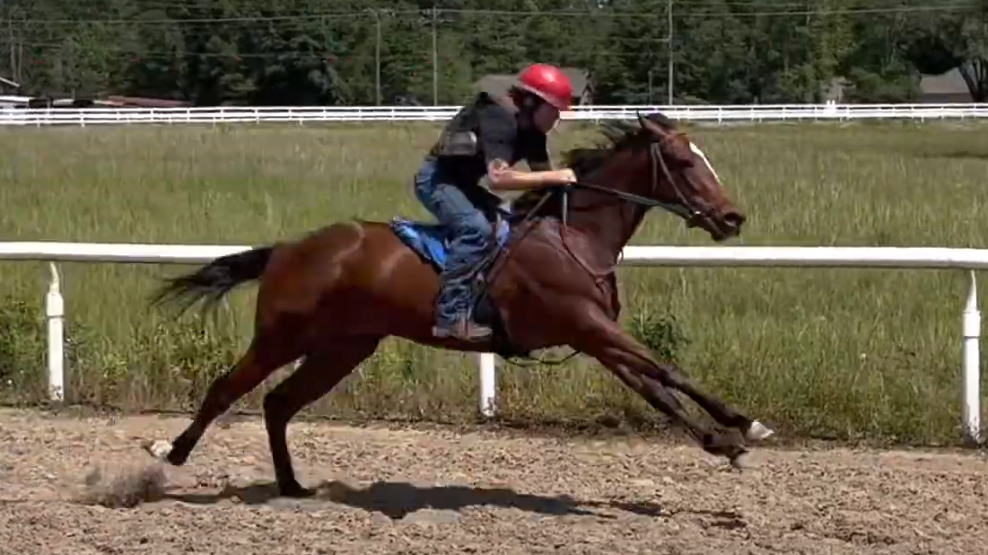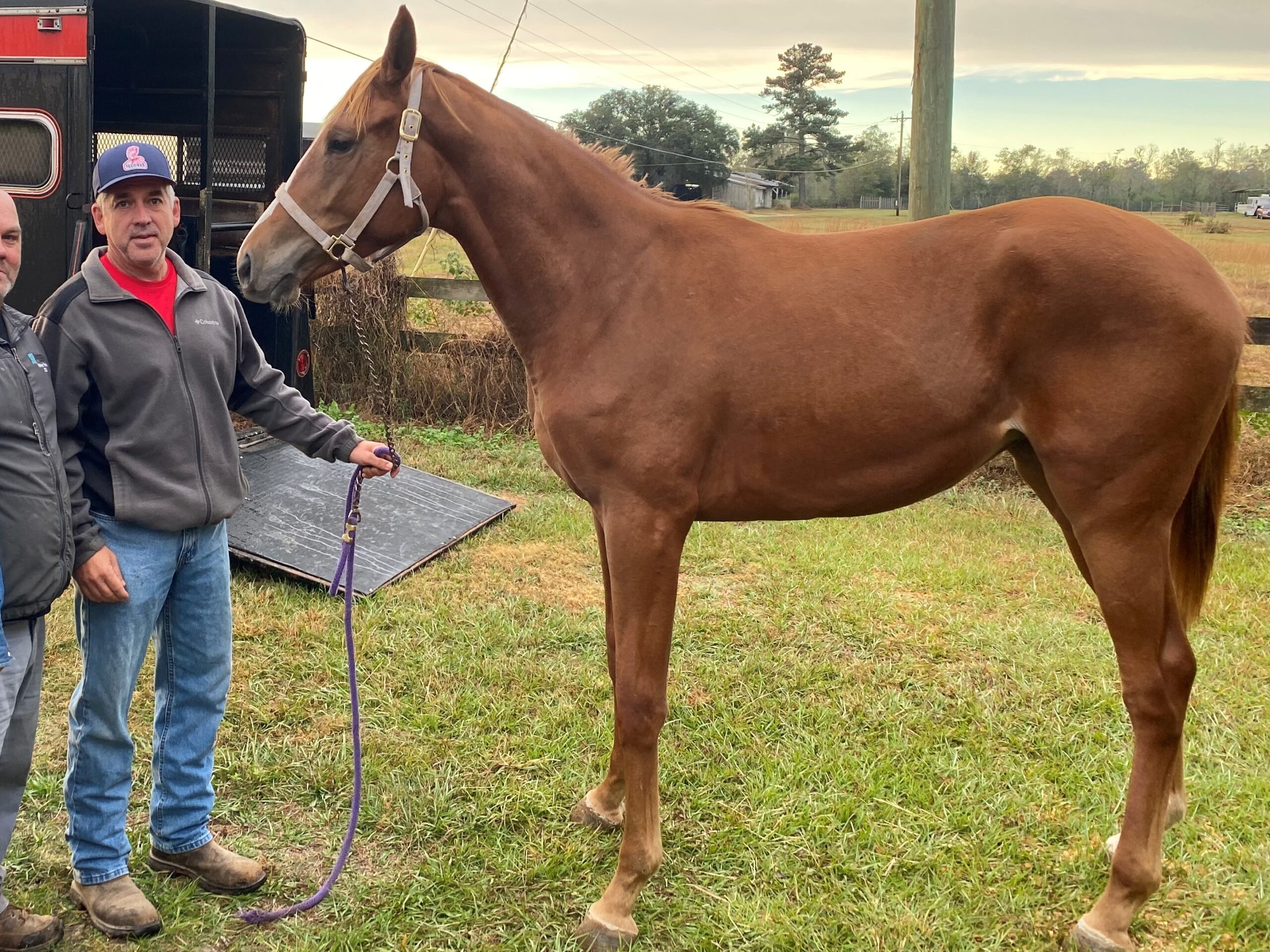Last updated: January 13, 2025
Any links on this page that lead to products on Amazon are affiliate links and I earn a commission if you make a purchase. Thanks in advance – I really appreciate it!
Many horse owners fear that a broken leg means euthanasia is inevitable. However, thanks to advancements in veterinary care, recovery is possible in some cases. With over 25 years of hands-on experience as a Thoroughbred racehorse owner and trainer—combined with in-depth scientific research—I’m here to explain the realities of equine leg fractures, explore advanced treatment options, and guide you in making the best decision for your horse’s health and future.

Understanding Why Horse Leg Fractures Are So Serious
To fully understand why a horse’s broken leg can be so serious, it’s important to first explore the physical challenges horses face when dealing with leg injuries.
The Unique Anatomy That Makes Horses Vulnerable to Leg Fractures
For horse owners, understanding why leg fractures are so serious is crucial for making informed and compassionate decisions. Horses are particularly vulnerable to leg injuries due to their unique anatomy and evolutionary design. As prey animals, horses evolved for speed, not durability. Their long, slender legs allow them to run quickly but are structurally vulnerable to high-impact injuries.
Below the knee and hock, horses have minimal muscle and soft tissue to protect their bones. This lack of support means that even with a cast, a broken bone has little natural stabilization. Additionally, horses instinctively bear weight on injured limbs and may attempt to flee when startled, worsening the injury.

Common Types of Leg Fractures in Horses
According to the UC Davis Center for Equine Health, fractures involving joints are particularly difficult to treat due to their complexity and impact on mobility. The most common types of leg fractures in horses include:
- Simple Fractures: Clean breaks where the bone remains aligned. These are often treatable with stabilization techniques like casting or internal fixation and typically have the best prognosis.
- Comminuted Fractures: Bones shattered into multiple fragments. These injuries are complex to repair surgically and carry a higher risk of poor healing due to bone instability.
- Compound Fractures: Open fractures where the bone pierces the skin, greatly increasing the risk of infection and making recovery far more difficult.
- Joint-Related Fractures: Breaks that involve the joints, often resulting in long-term mobility issues, arthritis, and a poor prognosis due to the difficulty of repairing joint surfaces.
Why This Matters
Recognizing the types and severity of leg injuries in horses is essential for understanding why treatment is so complex and why, in some cases, euthanasia may be the most humane option. However, veterinary advancements have made recovery possible in some situations, offering hope for both horses and their owners.

Treatment Options for Horse Broken Leg Recovery
While severe leg fractures often lead to euthanasia, advancements in veterinary medicine have made recovery possible for certain injuries. Below are the most effective modern treatment options available:
Surgical Solutions: Plates, Screws, and Casting
When my colt Percy was diagnosed with a diaphyseal spiral fracture in his cannon bone, I was devastated. His injury was severe, but after consulting with our veterinarian, we decided to move forward with Open Reduction and Internal Fixation (ORIF)—a surgical procedure offering the strongest support for healing weight-bearing bones.
According to the American College of Veterinary Surgeons (ACVS), early surgical intervention and stabilization significantly improve recovery outcomes in horses.
How ORIF Works
- Surgical Exposure:
The fracture site is carefully opened, allowing the surgeon to assess the injury and prepare the bone for repair. - Bone Fragment Alignment:
The broken bone fragments are precisely aligned to their natural position to ensure proper healing and restore weight-bearing ability. - Stabilization with Plates and Screws:
- Plates: A strong titanium or stainless steel plate spans the fracture for continuous support.
- Screws: Screws are carefully positioned to secure the plate, avoiding critical growth plates in younger horses.
- Locking Compression Plates (LCP): In Percy’s case, a 9-hole locking compression plate was applied to the dorsomedial aspect of his cannon bone, offering enhanced stability by locking the plate and screws together.
- Fluoroscopy Imaging:
Surgeons used real-time X-ray imaging (fluoroscopy) to guide the precise placement of the plate and screws, reducing the risk of complications.
Why ORIF Was the Best Choice for Percy
The locking compression plate provided Percy with enhanced stability by preventing movement between the bone and the implant. This was essential for healing a weight-bearing limb like the cannon bone. However, ORIF carries risks, including potential infection, implant failure, and post-operative complications.
After surgery, Percy required months of strict stall rest, paired with antimicrobials, anti-inflammatories, and carefully monitored rehabilitation exercises. This comprehensive care was critical to his recovery. While surgery like ORIF addresses bone stability, additional therapies can further support the healing process.
Regenerative Therapies: Stem Cells and PRP Injections
While ORIF provided Percy with structural support, regenerative therapies offer promising options for further healing.
- Stem Cell Therapy: Lab-grown cells are injected into the injury site to promote bone and soft tissue regeneration.
- Explore more Stem Cell Therapy in Dogs and Horses
- Platelet-Rich Plasma (PRP) Injections: Concentrated platelets from the horse’s blood accelerate healing by enhancing tissue repair.
- Learn more in this article by Buckeye Veternary Service: Platelet Rich Plasma (PRP)
Though still experimental, these treatments are gaining traction, particularly for performance horses or cases requiring advanced healing support.

Veterinary Care for a Horse Broken Leg
Immediate and expert veterinary care is essential for recovery. According to the ACVS, timely stabilization can prevent further damage and improve a horse’s chances of healing. In Percy’s case, consistent veterinary checkups and dedicated post-surgical care were vital to his progress.
Ethical Considerations in Treatment Decisions
Deciding between treatment and euthanasia is incredibly difficult. Owners must weigh the horse’s quality of life, potential suffering, and the financial demands of treatment. In some cases, continuing treatment may not be in the horse’s best interest.
I understand how challenging this decision can be. While Percy’s surgery was successful, not every horse can recover from such injuries. For some, humane euthanasia is the most compassionate choice when recovery is unlikely or would lead to chronic pain.
Percy’s journey taught me that while not every case of a horse broken leg has a hopeful outcome, advances in veterinary medicine and informed decision-making can give horses a fighting chance. If you find yourself facing a similar decision, I encourage you to consult with your veterinarian to explore the best path forward for your horse.
For a deeper understanding of the risks involved in racing, the video below shows the tragic injury of the champion racehorse Ruffian. Viewer discretion is advised.
Recovery and Rehabilitation After a Broken Leg
Successful recovery requires a strict regimen of stall rest, gradual exercise, and sometimes the use of supportive devices like slings. Slings can help redistribute weight for horses struggling to stand, reducing strain on both the injured and supporting limbs. This intensive care demands significant time, financial investment, and dedication.
Percy’s recovery involved not only strict stall rest but also daily hoof checks to monitor for signs of laminitis, gradual hand-walking to promote circulation, and regular veterinary check-ups to assess healing progress. His post-operative care included antimicrobials, anti-inflammatories, and carefully monitored rehabilitation exercises over several months.
Post-treatment care must also account for complications like Supporting Limb Laminitis (SLL). Research shows that improper weight distribution during recovery can lead to SLL, resulting in arterial blockages and hoof failure (J. A. Orsini, 2012). Preventative measures, such as controlled movement, supportive hoof care, and the use of heel wedges or padded shoes, are essential for reducing this risk.
Maintaining healthy blood flow during recovery is essential for healing. Horses rely on a natural ‘hoof pump’ mechanism to circulate blood through their legs. Prolonged confinement can reduce circulation, slowing healing and increasing the risk of secondary complications like laminitis, a painful and potentially fatal hoof condition.
Incorporating hand-walking, gentle weight-shifting exercises or using an underwater treadmill can stimulate blood flow and reduce these risks. Depending on the severity of the injury, recovery can take 6 months to over a year, with regular veterinary check-ups guiding each stage of healing, however, some severe fractures may require 18 months of rehabilitation.
While Percy successfully recovered, horses with more severe injuries, such as compound fractures or joint involvement, often face poor prognoses, making euthanasia the most compassionate choice. Balancing hope and realism is essential in making the best decision for the horse’s long-term well-being.

Preventing Leg Injuries in Horses
While proactive care greatly reduces the risk of leg injuries, even the most well-cared-for horses can suffer setbacks. Prevention involves careful management, but understanding how to respond when injuries do occur is equally important.
I experienced this firsthand with one of my three-year-old fillies. Despite receiving excellent care, she came back from a race with a slab fracture. Our veterinarian advised giving her three months of stall rest, followed by three months in a small paddock. Only after this extended recovery period could we assess how she responded to light riding. This experience reinforced that while prevention is vital, patience and proper rehabilitation are just as crucial for a horse’s long-term health.
Hoof Care, Nutrition, and Conditioning
Regular veterinary check-ups, proper hoof care, and balanced nutrition are vital for preventing leg injuries. Routine vet exams can detect early signs of musculoskeletal issues or nutritional imbalances that weaken bones. Customized hoof care—such as correct trimming and shoeing—supports even weight distribution and reduces strain on tendons and ligaments. Applying poultices after workouts helps manage inflammation and aids in recovery.
Gradual conditioning programs are also essential to strengthen bones and joints, while sudden increases in workload should be avoided. Incorporating cross-training activities like hill work and swimming can improve strength and flexibility, further reducing injury risks. According to the American Association of Equine Practitioners (AAEP), proper conditioning and hoof care are essential for preventing orthopedic injuries in horses.
Early Detection
Daily grooming is a valuable opportunity to identify early signs of lameness, swelling, or heat. Checking for subtle changes in gait or limb sensitivity can reveal underlying issues. Incorporating regular lameness evaluations and using tools like thermal imaging or hoof testers can help detect minor issues before they become serious.
Additionally, advanced technology like 3D scanning is revolutionizing early detection. A study titled “Measuring Volumetric Changes of Equine Distal Limbs” by Steven Johnson and Jennifer Symons highlights how 3D scanning can precisely measure changes in a horse’s leg volume after exercise. This allows for early identification of swelling or inflammation, leading to quicker interventions and better recovery outcomes.
Safe Environments to Reduce Injury Risks
Creating and maintaining a safe environment is essential for reducing the risk of leg injuries. Ensure turnout areas and paddocks are free from holes, uneven terrain, and hazardous objects. Proper drainage systems prevent mud buildup, reducing the risk of slipping. Proper stall flooring should provide cushioning that minimizes joint stress. Installing shock-absorbing footing in high-traffic areas and regularly maintaining fencing and shelter structures can further safeguard horses from avoidable accidents.

Frequently Asked Questions About Horse Leg Fractures
Many horse owners have important questions when faced with a leg injury in their horse. Below are answers to some of the most common concerns about treatment, recovery, and prevention.
How much does it cost to treat a horse’s broken leg?
The cost can range from $5,000 to $20,000 or more, depending on factors such as the fracture’s severity, the type of surgery required (e.g., plates and screws), hospitalization, pain management, and post-operative care like stall rest and rehabilitation.
How long does recovery take for a horse with a leg fracture?
Recovery can take 6 months to over a year and involves strict stall rest, gradual reintroduction to movement, regular veterinary check-ups, and sometimes physical therapy. Complications like infections or weight-bearing issues can prolong recovery.
Can horses return to performance after a broken leg?
In some cases, yes. Horses with simpler fractures and successful recoveries may return to light riding or even performance activities. However, high-impact sports may not always be possible, depending on the injury’s location and severity.
Are certain breeds more prone to leg fractures?
Yes. Thoroughbreds and Standardbreds, known for racing, are more prone to stress fractures due to high-speed activities. Draft breeds, like Clydesdales, may be more susceptible to joint-related injuries because of their heavier build. Conformation and workload also play roles in injury risk.
What are the chances of a full recovery after a leg fracture?
The chances of full recovery depend on the fracture type, treatment, and rehabilitation. Simple fractures generally have better outcomes, while complex or joint-involved fractures carry a higher risk of long-term complications or limited recovery.
How can I help prevent leg fractures in my horse?
Prevention involves regular veterinary exams, proper hoof care, balanced nutrition, gradual conditioning, and maintaining safe turnout areas. Monitoring for early signs of lameness can also help prevent minor issues from becoming serious injuries.

Conclusion
While severe leg fractures often lead to euthanasia, advancements in veterinary medicine have made recovery possible for certain injuries. Owners must carefully weigh the severity of the injury, the horse’s quality of life, and the feasibility of treatment. Prioritizing preventative care and early detection remains essential in reducing the risk of these devastating injuries.
Though facing a leg injury can be overwhelming, staying informed and working closely with your veterinarian can give your horse the best possible outcome. By taking proactive steps, you can better safeguard your horse’s long-term health and well-being.
Have you dealt with a horse’s leg injury? Share your experience in the comments below or explore more resources on horse care at HorseRacingSense.com. For expert tips, don’t forget to subscribe to our newsletter!
Additional Resources and Further Reading
- Books:
- “Equine Sports Medicine and Surgery” by Kenneth W. Hinchcliff and Andris J. Kaneps.
- “The Essential Hoof Book” by Susan Kauffmann and Christina Cline.
- Websites:
- The American Association of Equine Practitioners (AAEP) website for comprehensive resources on horse health.
- The Equine Injury Database for statistics and research on racehorse injuries.
- Documentaries and Films:
- “The First Saturday in May” is a documentary exploring the journey to the Kentucky Derby, including aspects of horse care and training.
- “Dark Horse” is a film that offers insight into the horse racing world and the bond between horses and their caretakers.
Related Articles:
- Why Are Race Horses Legs Wrapped? Training Secrets Revealed
- Are Racehorse Deaths On the Rise?
- How Long Does a Racehorse Live?
- Are Racehorses Mistreated or Pampered? The Cold Hard Facts.
- Is My Horse Lame? Subtle but Critical Signs to Watch For

About the Author: Miles Henry
Lifelong Horseman | Racehorse Owner | Published Author
Miles Henry brings over 25 years of hands-on experience training and owning Thoroughbred racehorses. Raised with Quarter Horses and Appaloosas, he’s spent a lifetime learning from horses—on the track, in the barn, and in the field. Today, he runs a small but successful racing stable in Louisiana and shares real-world insights on HorseRacingSense.com, helping horse owners, fans, and bettors navigate the sport with confidence.
📚 Books: View Miles’s books on Amazon »
🎧 Podcast Guest: Animal Tales Ep. 32 |
YouTube Interview
📩 Newsletter: Sign up for racing tips and horse care advice »
🔗 Follow Miles:
Twitter |
Facebook |
YouTube



